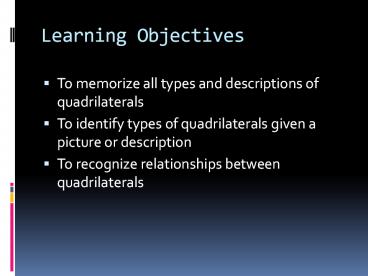Learning Objectives - PowerPoint PPT Presentation
1 / 21
Title:
Learning Objectives
Description:
Kite: exactly two pairs of congruent, adjacent sides. More Quadrilaterals ... All kites are parallelograms. All rhombuses are rectangles. All rectangles are squares. ... – PowerPoint PPT presentation
Number of Views:68
Avg rating:3.0/5.0
Title: Learning Objectives
1
Learning Objectives
- To memorize all types and descriptions of
quadrilaterals - To identify types of quadrilaterals given a
picture or description - To recognize relationships between quadrilaterals
2
7-7 Classifying Quadrilaterals
- Parallelogram 2 pairs of parallel sides
- Rhombus 4 congruent sides
- Rectangle 4 right angles
3
More Quadrilaterals
- Square 4congruent sides and 4 right angles
- Trapezoid exactly 1 pair of parallel sides
- Kite exactly 2 pairs of congruent, adjacent
sides
4
Types of Quadrilaterals
5
Give all the Names that Apply
6
True or False
- All squares are rhombuses.
- All kites are parallelograms.
- All rhombuses are rectangles.
- All rectangles are squares.
- All squares are rectangles.
7
Think and Discuss
- 1. Compare a parallelogram with a trapezoid.
- 2. Describe how you can decide whether a rhombus
is also a square. - 3. Discuss why a rhombus is not a kite.
8
Learning Objectives
- To determine the measure of unknown angles in a
triangle given the other two angles - To use diagonals to find the sum of interior
angle measures - To draw triangles to find the sum of interior
angles measures
9
7-8 Angles in Polygons
- Triangles add up to 180 degrees
- To find the unknown angle of a triangle, add up
the two known sides and subtract from 180.
10
(No Transcript)
11
Finding Angles of Polygons Method 1
- Diagonal segment drawn from one vertex to
another - Since we know triangles add up to 180 degrees,
divide each polygon into triangles to find the
sum of the polygons angles. - of triangles x 180 degrees sum of angles
12
Practice
- Divide each polygon into triangles and use the
formula - of triangles x 180 degrees sum of angles
13
(No Transcript)
14
Method 2
- Once you understand how to divide a polygon into
triangles, you can use this formula - 180 (n -2) sum of angles
- N stands for the number of sides in the polygon
- We subtract 2 from the sides because thats how
many triangles exist
15
Practice
- Use the formula 180 (n -2) sum of angles
16
Think and Discuss
- 1. Explain how to find the measure of an angle
in a triangle when the measures of the two other
angles are known. - 2. Determine for which polygon the sum of the
angle measures is greater, a pentagon or octagon. - 3. Explain how the measure of each angle in a
regular polygon changes as the number of sides
increases.
17
Learning Objectives
- To identify congruent figures in the real world
- To identify congruent triangles according to the
rule that makes them congruent - To memorize congruent triangle rules
- To use congruence to find missing measures
18
7-9 Congruent Figures
- Congruent same size and shape
19
Congruent Triangles
- Side-Side-Side (SSS)
- Side-Angle-Side (SAS)
- Angle-Side-Angle (ASA)
- Rules that dont work
- Goodwin Trouble (Angle-Side-Side)
- Car Trouble (Angle-Angle-Angle)
20
Which rule applies?
21
Which rule applies?































